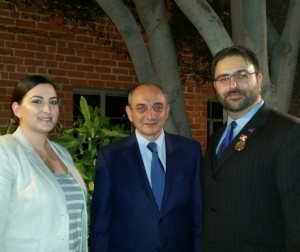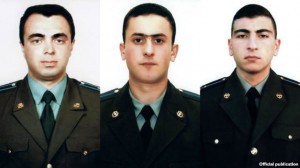By Hambersom Aghbasian
Ali Ertem is a Turkish journalist (Turkish citizen living in Germany). He is the Chairman of the “Union Against Genocideâ€, an Anti- Genocide organization based in Frankfurt- Germany , established by Turks residing in Germany. He is one of the Turkish intellectuals who have recognized the Armenia Genocide and is an active advocate of the Genocide recognition.
Panarmenian.net wrote on April 20, 2007, “ On the initiative of “Union Against Genocide†an event will be organized in Frankfurt on April 24, dedicated to the Armenian Genocide. Organizers demand to proclaim April 24 as a universal mourning day for all nations of Turkey. According to Turkish journalist Ali Ertem, head of the organization, other organizations will participate in the event too. Particularly they are, Federation of Turkish workers of Germany, Federation of Democratic Nations of Germany, Federation of Worker Immigrants of Germany, Union of Workers – Brotherhood of Nations organization and Union for Struggle newspaper. In its statement “Union Against Genocide†mentioned that, “Immigrants from Turkey feel great sorrow concerning the fact, that genocides, which took place 92 years ago and were committed between 1915-23 towards Christian nations of the Ottoman Empire with the aim to exterminate them, are being denied. The cutting of Christian population down to 0.1%, which before 1915 approximately was 1/3 of the Ottoman society, as well as bragging of Turkish nationalist leaders as if 99.9 percent of Turkey’s population was turned to Islam, is nothing else than a peculiar recognition of committing genocide towards our Christian neighbors.“ (1)
Noyan Tapan, wrote on April 25, 2006 “It is already several years that journalist Ali Ertem, a citizen of Turkey living in Germany, Chairman of the “Union Against Genocide†org., comes to Armenia on April 24 to pay the tribute of his respect to the memory of 1.5 million victims of the Armenian Genocide of 1915. Only some years ago the Turkish intellectual collected 11000 signatures from Turks of Germany and submitted them to the German and different European countries parliaments, and doing so, rendered assistance to the recognition of the Armenian Genocide. According to Ali Ertem, the top priority task of the organization headed by him is the recognition and condemnation of the Armenian Genocide by Turkey and Turkish society. They first submitted these signatures to the Turkish parliament, who checked and returned them giving no answer. “Hostility cannot last forever. One day Turkey should reconcile itself to the fact and should recognize the Armenian Genocide. I am convinced that the peoples living in Turkey will also condemn and admit this fact,†the Turkish journalist emphasized. In Ali Ertem’s opinion, in this respect the international organizations have much to do: they should be mediators in the dialogue between the Turkish and Armenian peoples in the issue of liquidation of the consequences of the Genocide.â€(2)
According to Asbarez .com, April 17th, 2003, (Noyan Tapan) reported that, the Chairman of the Frankfurt-based Union Against Genocide–Turkish journalist Ali Ertem stressed during a roundtable in Yerevan on April 17–that “The Turkish Government must offer an apology to the victims of the Armenian Genocide and their descendants.†The roundtable was organized by the students of Yerevan State University’s history department. After such an apology to set the stage–Ertem said that “what was taken from the Armenian people should be returned.â€(3)
Panarmenian.net wrote on April 17, 2003, “As reported by “Arka†agency, chairman of “Union Against Genocide†Ali Ertem, when giving a speech at Yerevan State University today said Turkey should be punished for the Armenian Genocide in 1915.†In his words,†it is Turkey’s duty to accept all consequences of the crime committed.†A. Ertem emphasized “the historical truth should be recognized in order to establish normal relations between the two peoples.†In his opinion, Turkey first of all has to apologize to the generation, which suffered the genocide. “The massacre of the Armenian people was perpetrated at the indifferent silence of “the civilized†European states, but the recent events in Iraq show the real degree of these countries’ being civilized,†A. Ertem said and added that sanctions against Iraq should have been applied to Turkey in their time. (4)
Under the title “Turkish Intelectuals say Turkey must recognize Armenian Genocideâ€, tallarmeniantale.com, an Anti-Genocide recognition source mentioned the following, “At commemoration ceremonies in Yerevan and Los Angeles, Turkish intellectuals called on Ankara to recognize Turkey’s responsibility for the Armenian Genocide. In Yerevan a delegation of Turkish intellectuals presented signatures from 10,000 Turks collected by a Frankfurt-based group called The Union Against Genocide. Ali Ertem, who headed the visiting delegation, read the letter accompanying the collected signatures. It said, “We have come to apologize to you and stretch out our hand of reconciliation.†The letter added, “Only recognition and confession can prevent the repetition of such tragedies in the future.†A similar gesture took place during commemoration ceremonies.(5)
According to www.newworldencyclopedia.org, Oct 16, 2006, Some Turkish intellectuals also support the genocide thesis despite opposition from Turkish nationalists; these include Ragip Zarakolu, Ali Ertem, Taner Akçam, Halil Berktay, Fatma Muge Gocek and Fikret Adanir. (6)
AIM, May 1999, stated that Ali Ertem, the president of the Association Against Genocide, declared in a letter addressed to the Armenian people “We are trying to correct the mistakes of our forefathersâ€, he added “As a Turk, I am ashamed. Today, the same Genocide continues against the Kurds.†Ertem headed a delegation of Turks, Kurds and Assyrians which participated in the Armenian Genocide commemoration ceremonies held at the Tsitsernakabert memorial in Yerevan. The members of the delegation were received by National Assembly Speaker Khosrov Harutunian and met with journalists and members of minority groups.†Ertem expressed his sorrow that “even after 85 years, his government has not sought the forgiveness of the Armenian people.†For Ertem, the Armenian Genocide is a crime against humanity.â€(7)
Ali Ertem was criticized by www.tallarmeniantale.com an Anti-Genocide recognition source because of his recognition of the Armenian Genocide.(8)
—————————
1-http://www.panarmenian.net/eng/world/news/21886/
2- http://www.armeniandiaspora.com/showthread.php?46623-Ali-Ertem-One-Day-Turkey-Should-Reconcile-Itself-To-The-Fact-AndRe
3- http://asbarez.com/48535/ali-ertem-says-turkey-owes-apology-to-armenian-genocide-victims/
4- http://panarmenian.net/eng/news/894
5- http://www.tallarmeniantale.com/TURKISH-SCHOLARS.htm-
6- http://www.newworldencyclopedia.org/entry/Armenian_Genocide
7- http://www.network54.com/Forum/13181/message/929566670/Ali+Ertem,+President+of+the+
8-http://www.tallarmeniantale.com/TURKISH-SCHOLARS.htm
Turkish Intellectuals Who Have Recognized The Armenian Genocide: Ali Ertem








